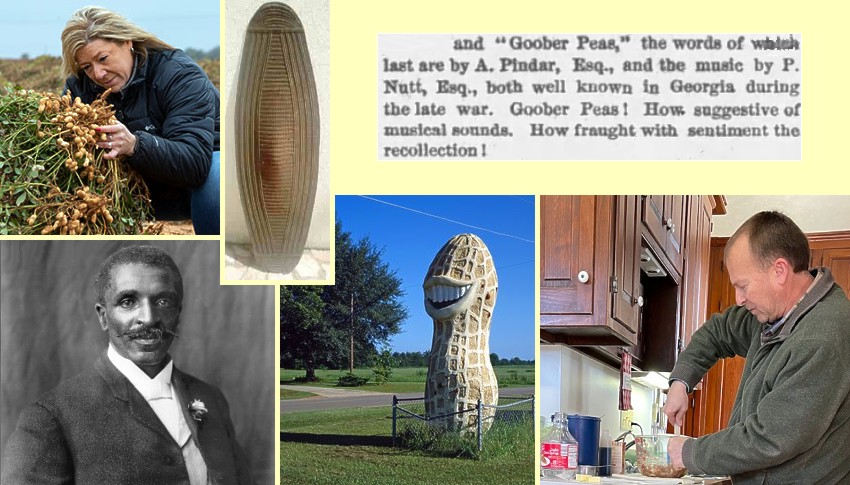Kansas Snapshots by Gloria Freeland - March 10, 2023
Goober peas
Last Wednesday, husband Art declared what sounded good for breakfast was "peanut-butter toast" - code for a couple of slices of
toasted bread slathered with peanut butter. He prefers extra-crunchy, while I opt for the creamy version, frequently
paired with apricot jam. My "extra-special" version means I'll cut the toast on a diagonal. Ah, the simple pleasures!
A few days later I discovered Art's March 1 request was on National Peanut Butter Lovers Day. The "holiday" - promoted by the Adult
Peanut Butter Lovers Fan Club and the National Peanut Board - first appeared in 1990. There is also National Peanut Butter Day
- Jan. 24 - and National Peanut Butter and Jelly Day - April 2. And, if those aren't enough, Sept. 13 is National Peanut Day.
The peanut - also called ground pea, earthnut, or goober - isn't actually a nut at all. It's a legume and is a close relative
of the black-eyed pea.
According to the National Peanut Board, the peanut plant probably originated in Peru or Brazil in South America. There are no
fossil records, but people in South America made pottery in the shape of peanuts or decorated jars with peanuts as far back as
3,500 years ago. There is also evidence ancient South American Incas were the first to grind peanuts to make peanut butter.
Peanuts were grown as far north as Mexico when the Spanish began their exploration of the Americas. The explorers took peanuts
back to Spain, but unlike coffee and chocolate, they didn't catch on. Traders and explorers spread them to Africa and the story
was different there. Some tribes called them nguba and others mpinda. The legume was introduced to North America via the slave
trade in the 1700s where nguba became goober and mpinda became pindar.
Peanuts as a U. S. commercial crop first appeared in Virginia in the early 1800s, principally as food for livestock and the
poor. Peanuts were considered difficult to grow and harvest.
But things began to change around the time of the Civil War. Art sometimes sings a little ditty, "Eating Goober Peas," but I
hadn't realized its origin was related to the war. According to the American Battlefield Trust, the song was popular with Southern
soldiers, who marched to the tune, and celebrated the legume as a staple of the Confederate Army's diet. Published in 1866, its
creators were listed as A. Pindar and P. Nutt.
Sitting by the roadside on a summer's day,
Chatting with my messmates, passing time away,
Lying in the shadow underneath the trees,
Goodness how delicious, eating goober peas!
Peas! Peas! Peas! Peas! Eating goober peas!
Goodness how delicious, eating goober peas!
The peanut was a favorite in the Union Army as well, being nutritious as it is high in protein.
The peanut's popularity grew in the late 1800s when P.T. Barnum's circus traveled across the country and vendors called "hot
roasted peanuts!" to the crowds. Street vendors began selling roasted peanuts from carts and peanuts became popular at baseball
games.
John Harvey Kellogg of cereal fame invented a version of peanut butter in 1895. Kellogg endorsed a plant-based diet and promoted
peanut butter as a healthy alternative to meat, which he saw as a digestive irritant and a sinful sexual stimulant. (I must
admit that there is very little I find sexy about peanut butter!)
George Washington Carver, trained in Iowa as a botanist, developed hundreds of uses for peanuts, including in Worcestershire sauce,
shaving cream and paper. Carver took over the agriculture department at Alabama's Tuskegee Institute in 1896. Cotton crops had
stripped the region's soil of its nutrients, so he began experimenting with peanuts and sweet potatoes, which could replenish the
nitrogen while helping Black farmers feed their families.
Around 1900, labor-saving equipment was invented for planting, cultivating, harvesting, picking, cleaning and shelling peanuts.
Demand grew rapidly. The peanut was also found to be a good source of cooking oil. So in both world wars, peanuts and peanut
butter became an integral part of the Armed Forces rations. It also provided families on the home front with an inexpensive source
of protein.
Peanut popularity jumped during the 1976 presidential campaign that put Jimmy Carter in the White House. Members of the Indiana
Democratic Party built an unusual statue in Evansville to honor Carter. The 13-foot-tall peanut, made from polyurethane foam
sprayed on metal hoops and covered with chicken wire, stands today, in Plains, Georgia, Carter's hometown, complete with his
trademark toothy grin, in honor of his early career as a peanut farmer.
But peanuts are not, well, just peanuts! The American Peanut Council informs us that for farmers, it is a $1 billion cash crop
- the 12th most valuable in the U.S. Americans spend almost $800 million a year on peanut butter.
In case you are curious, it takes about 540 peanuts to make a 12-ounce jar of peanut butter and the average American eats more
than 7.9 pounds of peanut products every year.
Like Art, I do like my peanut butter toast. But I'll also dip slices of apples or sticks of celery in the gooey stuff. I also
enjoy Pad Thai - a dish made with rice noodles, peanuts, scrambled eggs, fresh vegetables and chicken or rice. But my favorite
peanut "dish" is the peanut brittle friends Susan and Dave make every Christmas with their three children. Dave gave us the
recipe and a bag of the melt-in-your-mouth brittle for the holidays. I took possession of the latter! I told them it
was the best I've ever tasted - and I like the fact it's not a tooth-breaker!
Goodness, how delicious!
